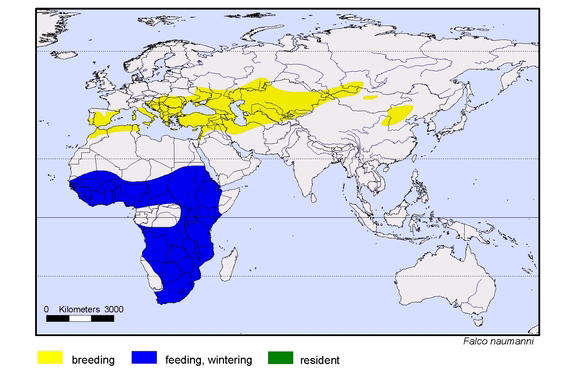
| Species fact sheet | by Global Register of Migratory Species - www.groms.de |
| Use the GROMS database for dynamic search for migratory species, new links and references. |
| Falco naumanni | Fleischer, 1818 |
| Synonym: | |
| Family: | Falconidae |
| Order: | Falconiformes |
| English: | Lesser kestrel |
| French: | Faucon crécerellette |
| Spanish: | Cernícalo primilla |
| German: | Rötelfalke (There's a German version of this page!) |
| Norwegian: | Rødfalk (There's a Norwegian version of this page!) |
| Migration: | intercontinental “Mainly trans-Saharan migrant, although some birds winter in NW Africa and in various regions of S Europe and S Asia, e.g. S Spain, S Turkey, Azerbaijan; occurrence in India, and perhaps in Burma, probably refers to birds on passage, with only stragglers overwintering. Most birds migrate to S Africa. Nomadic movements in winter related to local concentrations of insects. Following post-breeding dispersal, birds fly to winter quarters, mainly in Sept; return to breeding areas varies with latitude, Feb in Morocco, Mar-Apr in Europe; juveniles return later. Migrates across broad front, often in large flocks, sometimes mixed with F. vespertinus or F. tinnunculus.” From: del Hoyo J, Elliott A, Sargatal J (eds), 1994, Handbook of the birds of the world. Vol. 2: New World Vultures to Guineafowl, 638, Lynx Edicions, Barcelona, p. 259 |
| Regions: | East Asia, Europe, North Africa, North Asia, South & Southeast Asia, Sub-Saharan Africa, West & Central Asia |
“The lesser kestrel breeds in an extensive but increasingly fragmented range over the Mediterranean, south-eastern Europe and central Asia. Birds winter mainly in sub-Saharan Africa but are reported also for southern Spain and Turkey (Bird Life International 2000, del Hoyo et al. 1994). All populations undertake long-distance migration and congregate in large numbers in the wintering grounds (Government of the Republic of Hungary 1996). The western European populations' rapid decline by up to 95% since 1950 highlight the species' vulnerability (Bird Life International 2000, Hilton-Taylor 2000). Moreover, the species has vanished from the Ural region of Russia and from northern Kazakhstan (Biber 1996). Estimates for South African wintering populations are less than 60,000 birds, representing a decline of over 50% since 1971 (Bird Life International 2000). Agricultural intensification, afforestation and urbanisation are the major threats for the lesser kestrel, leading to habitat loss and degradation in its western Palearctic range (Bird Life International 2000, Heredia et al. 1996, Tella et al. 1998). Due to its serious population declines, the lesser kestrel is listed in CMS Appendices I & II and CITES Appendix II.”
From: Riede, K. (2001): Global Register of Migratory Species. Weltregister wandernder Tierarten. Münster (Landwirtschaftsverlag), p. 251
Further detailed information from the GROMS-database
Recommended link(s):
| ARKive | Lesser kestrel (Falco naumanni): description, pictures, movies... |
| www.hawk.conservancy.org | |
| Animal Diversity Web | University of Michigan - Museum of Zoology |
| www.birdguides.com | |
| Oiseaux.net | (in French) |
To gather more information about birds in general see the link collection at connotea.org: aves
Please help us by updating our link collection via connotea!
Feedback: mail to: Klaus Riede
by Ansgar Tappenhölter